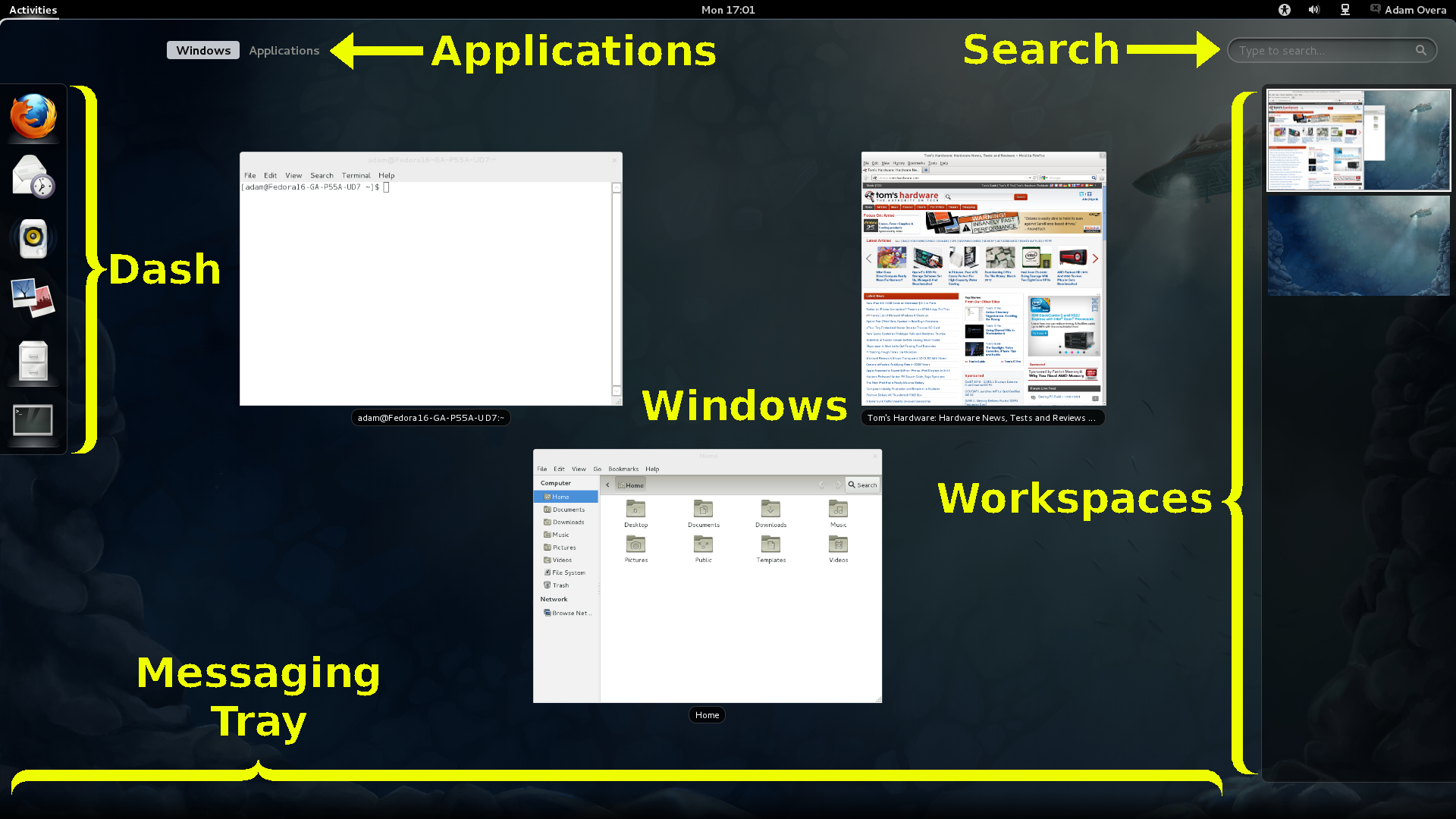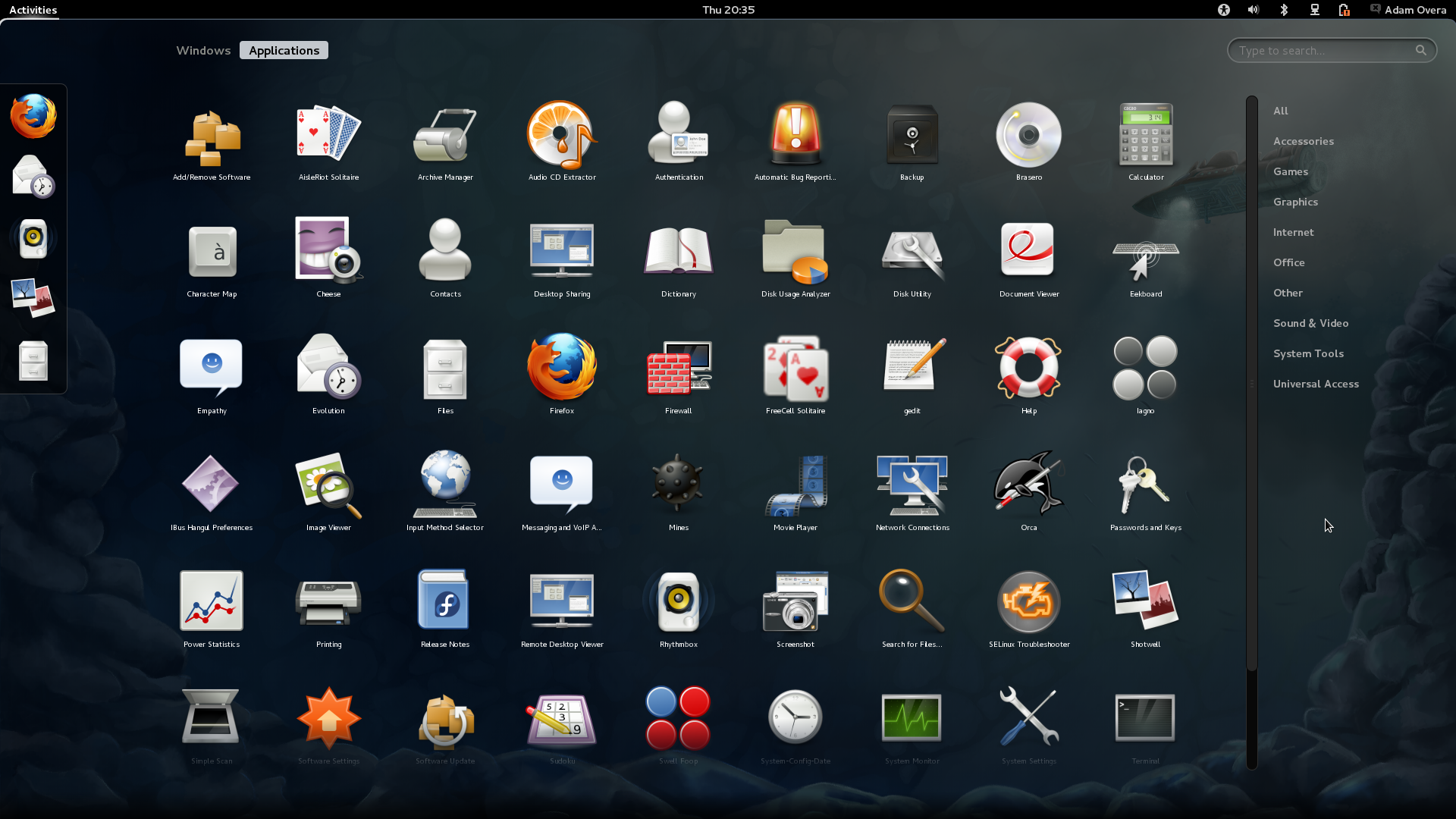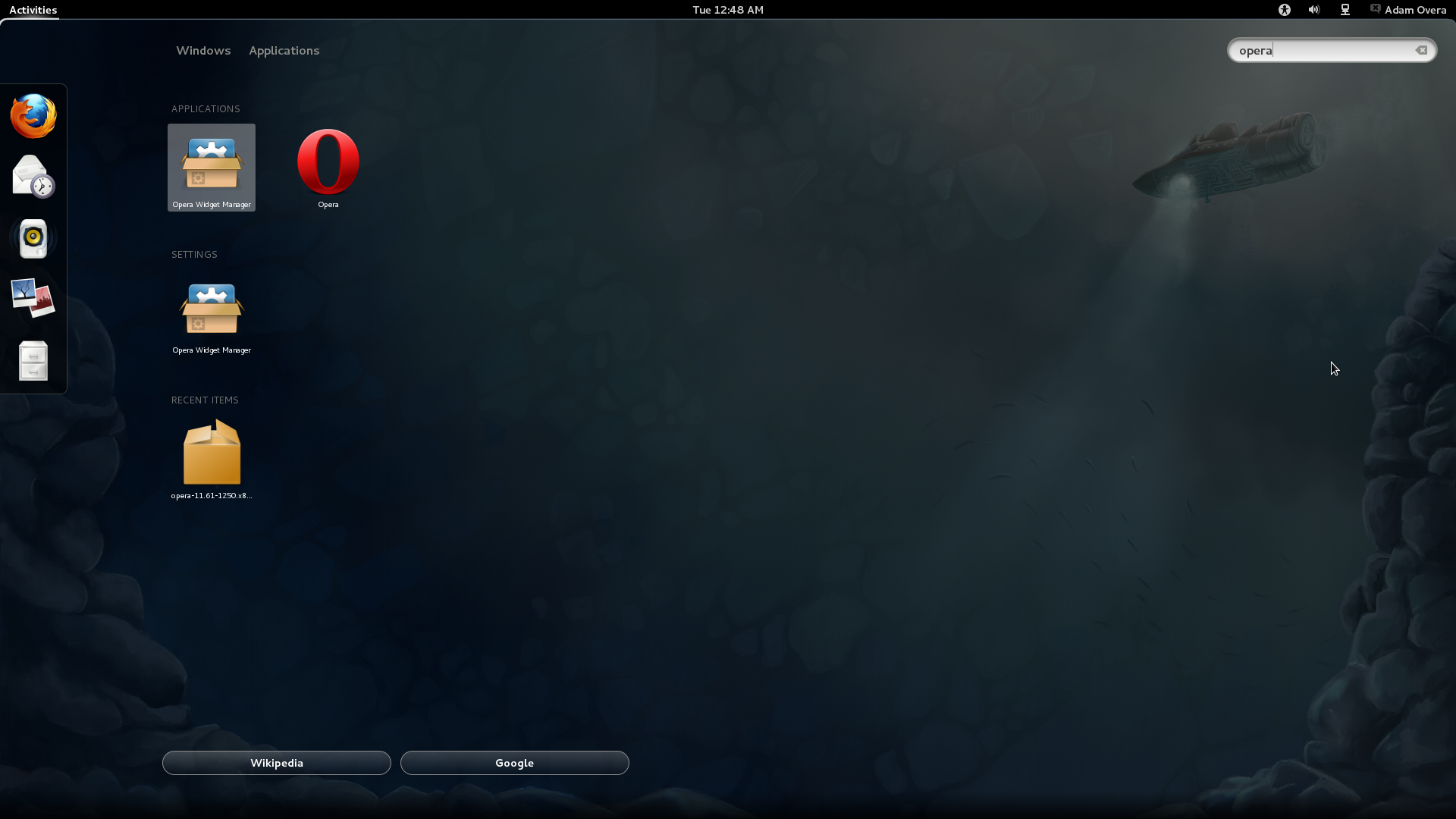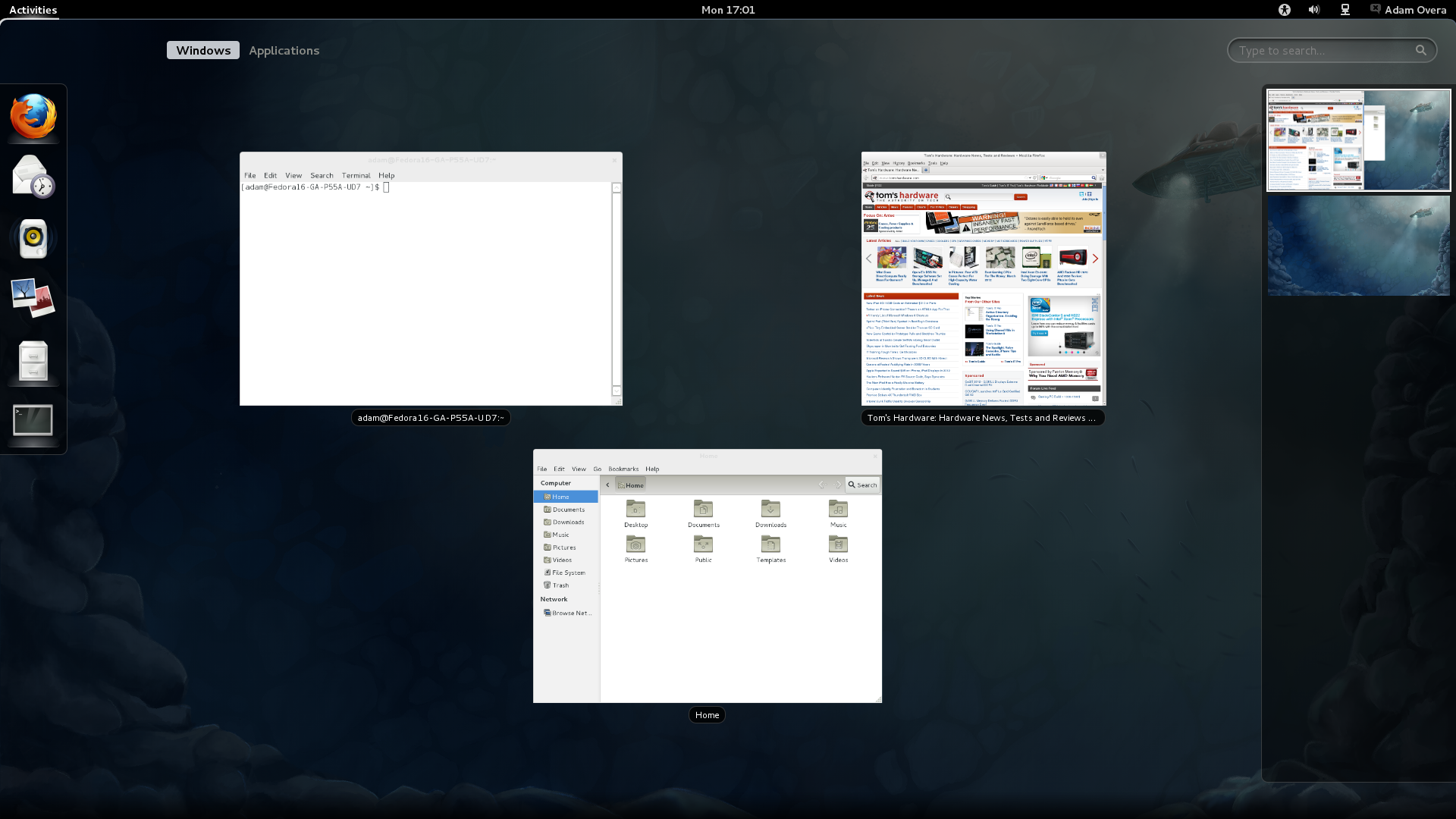Fedora 16 And GNOME Shell: Tested And Reviewed
Ubuntu and Mint don't want it; Linus called it an “unholy mess.” While most other distros are passing up or postponing GNOME Shell, Fedora is full steam ahead. Does Red Hat know something the rest of us don't? Or is GNOME 3 really as bad as everyone says?
GNOME Shell Activities/Overview
Taskbar + Start Menu = Activities/Overview
The whole Activities/Overview change has been a source of puzzlement to many of the folks who followed the early development of GNOME 3. The best way we can describe the Overview to a Windows-oriented audience is: taskbar and Start menu in one. Imagine if the Windows taskbar lacked a task/window list, but simply hosted the notification area and the Start button. The list of open applications and windows would then be located within the Start menu.
The Activities button in GNOME 3 replaces GNOME 2's Applications/Places/System menu. Instead of a menu, the Activities Overview is a full-screen overlay housing various OS controls. The Activities Overview is separated into five main areas: Dash, Windows, Applications, Search, and Workspaces. The Messaging Tray is also locked in place in the Overview.
Dash
Like Ubuntu's Unity, GNOME Shell also has an element known as Dash. Unlike Unity, where Dash is essentially the Start menu, GNOME 3's Dash is an off-screen dock. Favorite applications can be pinned to the Dash where their icons serve as quick-launchers.
The icons of open applications also appear in the Dash. A subtle spotlight effect underneath the icons of open applications differentiates them from pinned quick-launchers.
Windows
Get Tom's Hardware's best news and in-depth reviews, straight to your inbox.
When the Overview is activated, the bulk of the screen displays the Windows view by default. The Windows area of the Overview presents all of the currently-open windows in a way that's very similar to the Compiz plug-in, known as window spread.
In Windows mode, the user can switch to other windows, close windows, and move them to other workspaces (explained later).
Applications
Near the top of the Overview, next to Windows, is Applications. Selecting Applications changes the bulk of the screen from Windows view to Applications view.
The Applications view lists all of the installed applications as large icons. The listing is in alphabetical order, though a right-side pane holds traditional application categories. Selecting a category narrows down the full list, only displaying applications from the selected category.
While there are text labels below each application icon, the size of the text is comically small when juxtaposed against the oversized icons. The font used wouldn't have been our first choice, either. Between the diminutive writing and font, the labels are sure to cause more eye strain than their existence is worth.
Search
The Overview also features a search box in the upper right-hand corner. Semantic search results are provided by Zeitgeist. Typing characters into the box instantaneously populates the Overview with relevant applications and files. The Wikipedia and Google buttons near the bottom of the screen open a Firefox window with the corresponding search results page for the term entered.
Workspaces
GNOME 3 employs the same workspace metaphor as MeeGo (previously known as Moblin, now Tizen). Instead of a predefined number of virtual desktops, GNOME 3 spawns new workspaces as needed.
The way this works is pretty simple. There is one more empty workspace than the number of workspaces currently in use at all times. Moving any window to the extra desktop spawns a new empty workspace. Thus, you can never run out of workspaces. The on-screen representations simply get smaller and smaller in order to fit more workspaces in the Overview.
If that still seems confusing, the video below is more illustrative.
Current page: GNOME Shell Activities/Overview
Prev Page GNOME Shell Desktop, Panel, And Notifications Next Page Input Shortcuts, Tips, And Tricks-
gz3ro I think the akmod graphics drivers (also found in the rpmfusion repository) would be better than simply the proprietary drivers because they also work after kernel updates.Reply -
Verrin I'm really disappointed with the direction Linux has taken in its user interfaces. I was a big fan of Ubuntu until they switched to Unity, and since then I've been jumping from distro-to-distro trying to find a desktop environment that feels comfortable, isn't terribly difficult to wrap my head around, and that is still powerful. I was using GNOME3 for a while with Linux Mint, but even with the heavy extensions, there are certain functions that I can't quite replicate from the GNOME2 heyday. I wasn't able to get into KDE or XFCE either. They feel aged and aren't quite as sleek as other modern desktop environments, even if you try to fix that by adding customs skins.Reply
In the end, I'm downgrading to a much older distro of Ubuntu, and supplementing it with Windows 7. I'll be keeping an eye in the coming years to see how these rusty GUI releases turn out-- hopefully for the better. But for now, linux has lost a lot of its useability and it's flare. I'll miss the days when upgrading to a newer distro actually felt like an upgrade, but maybe after all these mistakes, developers will learn and make Linux exciting again. I'll be waiting to see. -
Good grief. What I wouldn't have done years ago for a job that would ask me to write a review on something that would obsolete itself in six months.Reply
Nobody, IMHO, who actually uses a computer for anything of value wastes their time with Fedora. You can't upgrade it, so your own personal enhancements and bug fixes are lost. Features you like are abandoned for broken replacements. Fedora is a nightmare and has been since it began. I began the adventure years ago with Red Hat 5 and finally gave up and moved to more useful distros after Fedora 8. Fedora is now for the masochistic.
On the other hand, if you like superficiality, as in wallpaper and clock positions, and enjoy the animated struggle that comes with installing something new all the time and reporting bugs then Fedora is a good thing. -
yumri one thing which i would have liked to see on the comparesion would be open time of a Libre Word Processing file, close time of that file, open time of a database file, close time of it, open time of Firefox, close time of Firefox, open time of a typical website like this one, close time of it, install time of the OS, how fast does it run a batch file or equivalent in the OS, and etc. like that things which we actually do a lot besides gaming.Reply -
yumri It also seemed like they had a basis towards the GUI way of doing things and thought all users had forsaken CLI scripting for their installs and updates. as if you are getting Fedora you most likely know it was command line based in the start and really is still easier to do everything from command line then from any other route well Ubuntu is made with the GUI interface in mind so things are easier to do with that then with command line mainly because they hid the terminal screen in the newer versions of it.Reply
With that Fedora is also made for workstations and Ubuntu made for end user support 2 differnet applications so why only show benchmarks of end user things and not anything on network support, domain support, VM thin client viability, accessing files from the network, etc. like that things which Fedora is good at not just things which Ubuntu is I think this article was basised and another should be made with more benchmarks to not be as basised towards one or the other. -
amdfangirl One of these days, developers of GUIs will realise going "forward" doesn't equate to an increase of ease of use and functionality.Reply
Unity, Metro, GNOME 3, Etc.
Alas, I must suffer each day for the Wacom preferences panel in GNOME settings. Ties me to GNOME 3 (or a derivative). How silly. -
palladin9479 Now I'm waiting for them to do a Solaris 10 or 11 review. Their both available on x86 so they don't even need to purchase new hardware. Come on it's a "real mans" OS.Reply -
You've completely missed extensions.gnome.org and gnome-tweak-tool, and as a result your review is not an accurate reflection of gnome-shell. Gnome-tweak-tool gives things like "Have file manager handle the desktop" and "Trash icon visible on desktop", plus shell, window, and gtk theme selection, font configuration, and gnome-shell extension management. Extensions.gnome.org provides, well, gnome-shell extensions. Things like "Static Workspaces", which gives you a fixed number of workspaces. Or "Alternative Status Menu", which puts power, reboot, suspend, and hibernate on your status menu. Or "Applications Menu", which provides a Gnome2-like list of windows on the current workspace.Reply
Now, I admit that neither of these configuration options are immediately visible to a new user. Despite that, your review is bad, and you should feel bad. -
zhihao50 graph for POV-Ray is wrong, you said both of linux finished 4min before windows yet the graph show the other way around.Reply -
adamovera Cowardly AnonYou've completely missed extensions.gnome.org and gnome-tweak-tool, and as a result your review is not an accurate reflection of gnome-shell. Gnome-tweak-tool gives things like "Have file manager handle the desktop" and "Trash icon visible on desktop", plus shell, window, and gtk theme selection, font configuration, and gnome-shell extension management. Extensions.gnome.org provides, well, gnome-shell extensions. Things like "Static Workspaces", which gives you a fixed number of workspaces. Or "Alternative Status Menu", which puts power, reboot, suspend, and hibernate on your status menu. Or "Applications Menu", which provides a Gnome2-like list of windows on the current workspace.Now, I admit that neither of these configuration options are immediately visible to a new user. Despite that, your review is bad, and you should feel bad.See pages 12 through 16.Reply




